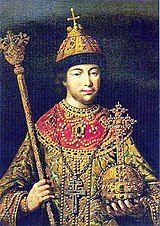Regalia of the Russian tsars
The barmas belonged to the local knyaz family, but in 1237 the city was completely destroyed by Batu Khan, so the forsaken jewellery lay underground for nearly 600 years.
Its name is connected with a Russian legend of the 15th century, according to which it was brought to Russia in ancient times as a gift from the Byzantine Emperor Constantine Monomachos.
In the first quarter of the 18th century, after Peter the Great's reforms, the ceremonial setting for reigning was replaced by coronation, the main attribute of which became the imperial crown.
Since the 18th century the Cap of Monomakh served as the heraldic crown of the "Tsardom of Great, Little and White Russia".
It was first mentioned in the treasury of Tsar Ivan the Terrible, whose reign was marked by a series of important events in Russian history.
The precious crown might have been executed by Moscow Kremlin jewellers on the successful solution of "The Eastern problem", so important for Muscovy.
At the same time, the combination of stones, e.g. red tourmalines and rubies with blue turquoise and the carved ornament of knitting herbs on a niello background represent oriental artistic influence.
The throne was made of wood faced with plates of ivory and walrus tusk, therefore it was called the "carved bone armchair".
The depicted themes, the style of the carving and the motifs, which include grotesques and Cupids, enable researchers to date most of the pieces to the 16th century and attribute them to Western European Renaissance craftsmen.
[5] The Sceptre and orb are creations of West-European jewellers of the late Renaissance period, the enamels used on the relief technique not being known to Russian goldsmiths of that time.
The sceptre and orb miraculously survived through the Time of Troubles and must have been used in 1613 in the crowning of Michael Fyodorovich, first Tsar of the Romanov Dynasty.
Most important of these things are: After Tsar Mikhail Fyodorovich's death, the Kremlin Armoury was given his personal jewels and equipment, not applied to the "Grand set".
















